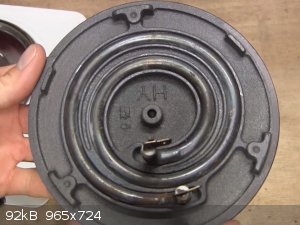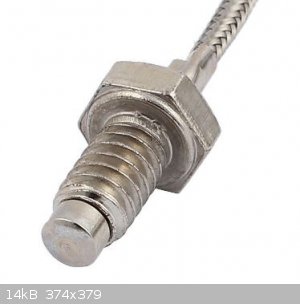| Pages:
1
2 |
kulep
Harmless

Posts: 46
Registered: 19-5-2018
Location: Somewhere below the tropic of Capricorn
Member Is Offline
Mood: Spicy
|
|
Cheap cooking hotplates have a threaded hole in the middle, although heat distribution across the top isn't optimal they are very robust and I don't think you would have a problem with the heating elements
burning like him, and even if they do burn replacements should be very cheap.
In that hole (6mm or 8mm maybe?) you can screw a threaded k-type thermocouple and use it as feedback for a pid controller. The hole is intended to
mount the element to the chassis but some models also have mounting holes in the rim, and in the ones that don't it should be easy to drill new ones.
It should all cost less than 30usd for at least 1000w power, you won't have stirring but maybe you can fit a motor and a hdd magnet under there, I
don't know how feasible it would be because the element is pretty thick; there's also the option to use overhead stirring.
https://www.youtube.com/watch?v=s2Pbh29QxoM
https://www.youtube.com/watch?v=075D_tuswVU
 
[Edited on 2-6-2018 by kulep]
|
|
|
zed
International Hazard
    
Posts: 2283
Registered: 6-9-2008
Location: Great State of Jefferson, City of Portland
Member Is Offline
Mood: Semi-repentant Sith Lord
|
|
Most of the stuff we use, isn't explosion or fire proof. So, in the event a container of flammable solvent breaks or is otherwise spilled on your
hot-plate; expect fire. Likewise, a regular lab hotplate, may ignite Ether, or other dangerous vapors.
Now, if your are working with aqueous solutions, it is a little easier.
I recently bought a Brand new "Elite" type hotplate, at my local Goodwill, fer 5 bucks.
Just for boiling water, etc. https://www.amazon.com/Cuisine-ESB-301F-Maxi-Matic-Single-El...
It was able to boil a liter of water, in a Schott-Duran, Melita coffee pot, pretty quickly. So, for boiling water= decent. The large flat plate,
should minimize "Hot" spots, and as long as I avoid putting cold glass on a blazing hot heating surface, it should be OK.
It wouldn't get hotter though. Set on high, it shut off, at about the BP of water. Has a thermostat. My argument is for less sophistication.
Without that thermostat, the hot plate would do what I want it to do.
As it is, if I want it to do more... I'll have to gut it like a fish, and rewire it.
[Edited on 2-6-2018 by zed]
[Edited on 2-6-2018 by zed]
|
|
|
coppercone
Hazard to Others
  
Posts: 133
Registered: 5-5-2018
Member Is Offline
|
|
An explosion proof hot plate stirrer is an interesting design idea. I mean so long its not the heat from the heating element that sets it off.
It might prevent a reaction occuring in butane, ether, gasoline from blowing up.
Ideas for design:
-use alot of poles in the motor to decrease bulk inductance and design it to operate at low voltage. Brushless kind.
-use low voltage to heat the plate
-desifn the electronics with lots of transient voltage supressors to eliminate arcing from broken connections
-seal it real good
-power it from an external dc supply that is outside of the fume hood. Be sure to put heavy voltage clamps on it
I also wonder if you can make a solid state stirrer that uses a ring of electromagnets to rotate the solenoid rather then using a spinning bar magnet.
By eliminating the vibration generated by a motor you are increasing reliability that can be caused by vibrations of solder joints. And it would be
nice and quiet.
|
|
|
weilawei
Hazard to Others
  
Posts: 130
Registered: 3-12-2017
Member Is Offline
Mood: No Mood
|
|
I work in environments with potentially flammable atmospheres, so we make heavy use of explosion-proof components. An interesting thing to note about
them is that an explosion-proof device isn't required not to cause an explosion--merely to contain it and prevent propagation. For example, our lights
are standard fluorescent, just inside a well-sealed housing.
|
|
|
coppercone
Hazard to Others
  
Posts: 133
Registered: 5-5-2018
Member Is Offline
|
|
well thats the cheap way to do it, but there is degrees of saftey
An overheating component like a resistor can maybe ignite fumes, but a spark can do it much easier, but its best if there is no fumes in the first
place.
There are layers of protection on everything, same with electrical isolation, how strong it is, how many different barriers need to be breached.
I would argue for intrinsically safe design of all system elements not to try to hide something that can be replaced...
I would argue for DC being brought in from outside the room into the lights. 
What if someone hits it with something and vapor gets in?
[Edited on 5-6-2018 by coppercone]
|
|
|
kulep
Harmless

Posts: 46
Registered: 19-5-2018
Location: Somewhere below the tropic of Capricorn
Member Is Offline
Mood: Spicy
|
|
Solid state electronics are intrinsically spark-proof, the only thing you would need is a tube of mega grey silicone and completely seal all holes and
crevasses of the enclosure, to be sure. A brushless motor is nice specially because it is very long lasting.
Why would you have a hotplate inside a fumehood with an stoichiometric amount of gasoline and air anyways?
|
|
|
coppercone
Hazard to Others
  
Posts: 133
Registered: 5-5-2018
Member Is Offline
|
|
if there is a high current and a wire or trace breaks it can spark because of inductance though. You need to be careful. Potting is kind of a mixed
bag because it can degrade the life time of electronics because of thermal properties and sometimes mechanical behavior.
more of an issue for operating in a gas filled mine shaft I think
sealed enclosure is a good start always
[Edited on 5-6-2018 by coppercone]
|
|
|
zed
International Hazard
    
Posts: 2283
Registered: 6-9-2008
Location: Great State of Jefferson, City of Portland
Member Is Offline
Mood: Semi-repentant Sith Lord
|
|
I'm thinking my LED bulbs are a lot safer than my old incandescents.
The bulbs don't get very hot, and they surely don't do that trick where the glass bulb section, de-laminates from the metal base... Falls straight
down, and abruptly exposes the white hot tungsten filament to the ambient atmosphere.
As a bonus, since switching from florescent bulbs, to LEDs... My electric bill has dropped by about half. I use a lot of light.
As for motors, my buddies used to do a lot of large scale LiAlH4 reductions in Diethyl-Ether. The sludge generated at certain stages, required strong
overhead stirring. They used high torque, low speed, explosion proof, DC motors. I don't remember the details, but it was specialized equipment, and
I remember the bitching. The motors and controllers were quite expensive.
I've considered induction as a possible method to provide reactant heating, utilizing appropriate vessels; but the economically available units have a
very high incidence of quickly failing. And, then....there is an internal fan, that cools the guts. But, at what peril?
[Edited on 6-6-2018 by zed]
|
|
|
Funkerman23
Hazard to Others
  
Posts: 416
Registered: 4-1-2012
Location: Dixie
Member Is Offline
Mood: No Mood
|
|
Quote: Originally posted by JJay  | I use Glas-Col fabric heating mantles, which I regulate using simple electronics equipment that I wired together. They are pretty inexpensive on the
secondary market, less expensive than the Asian heating mantles. I don't think the Glas-Col mantles are extremely durable, but I haven't had any
problems with mine. The tricky part is finding one with a power cord.
[Edited on 23-5-2018 by JJay] |
All due respect: As far as I knew Glas Col was the standard by which all other mantles are measured by. If they aren't that to you, what brand of
mantle is the standard? I may have missed something but Glas col is like the Corning of mantles here. They are dead nuts reliable.
" the Modern Chemist is inundated with literature"-Unknown
|
|
|
zed
International Hazard
    
Posts: 2283
Registered: 6-9-2008
Location: Great State of Jefferson, City of Portland
Member Is Offline
Mood: Semi-repentant Sith Lord
|
|
"Why would you have a hotplate inside a fumehood with an stoichiometric amount of gasoline and air anyways?[/rquote]"
Well, that's pretty much the kind of thing, that we are constantly required to do.
Like in Henzelmanns famous procedure; where toluene, nitroethane, and benzaldehyde... Are refluxed under a Dean-Stark trap, which is removing formed
water, as the reaction proceeds.
Ideally, no toluene escapes into the atmosphere, but we don't live in a perfect world. So, this project needs plenty of ventilation.
In the case of Diethyl ether; you may be required to boil it, for your reaction to proceed. And, despite all precautions, some Ether always seems to
escape containment. Gotta disperse the vapor and blow it away, otherwise it may "Blow you away".
[Edited on 11-6-2018 by zed]
|
|
|
nimgoldman
Hazard to Others
  
Posts: 303
Registered: 11-6-2018
Member Is Offline
|
|
The main issue I have with the chinese hotplate/stirrer (FAITHFUL SH-3) is the regulation of stirring. It is very sensitive to variation in voltage so
the stirring is not constant, especially with low revolutions - sometimes the stirring even stops completely by itself or speeds up randomly!
Another problem is quite weak magnet so the hotplate for 2 liter beaker does not handle anything large than a 2 cm stirrer - it just wiggles but does
not do any mixing.
Other than that, it mostly does the job, but I wouldn't use it for mission-critical application.
Expensive stirrers like IKA have special circuits to smooth out voltage just to keep the stirring constant, apart from other tweaks like precise
temperature control.
|
|
|
Dr.Bob
International Hazard
    
Posts: 2736
Registered: 26-1-2011
Location: USA - NC
Member Is Offline
Mood: No Mood
|
|
I can agree that some Chinese glassware is fine. But having used some Chinese electronics, I would stay away from them.
As stated, you can buy used US hotplates, stirrers, and heating mantles used for a low price, maybe not even as cheap as Chinese ones, but they will
generally be better. I use Corning and other US made stir/hotplates daily, some of them are 10-20 years old. They have been abused, corroded with
acids, and had goo spilled on them, but still work. Not to say that they cannot break, I have had to have a few fixed, but the parts are available,
and I have had a few people fix them from here. But you can buy a good used one for $80-160 typically.
As for heating controllers, I would go with a triac dimmer anytime, a 10 amp light dimmer works fine, easy to splice into an extension cord in a metal
electrical wiring box, cost is about $10. They work fine for most mantles and they are not expensive. But if you want a nice Variac, for nice, clean
voltage control, I have a few used ones for about $80-100. They are well made and not junk like the Chinese ones. Others are also selling used good
quality stuff on Ebay, just make sure that they have good ratings.
[Edited on 12-6-2018 by Dr.Bob]
|
|
|
| Pages:
1
2 |